
Mark Cobb reflects on the differences between being able to climb something and not being able to climb something: the subtle variations in technique, tactics and the shifts in mindset that ultimately make all the difference...
That feeling.
Excitement, a touch of fear, the surge of adrenaline.
The anticipation has been growing since yesterday. Spreading out from my thoughts, tracing the lines of bouldering problems through my fingers. It's always the same before we go climbing. In fact, maybe it's more exciting each time.
Just the thought of actually seeing that new problem and knowing whether it's 'doable'.
It's definitely in my head the night before. I'm imagining the holds, visualising where I put my feet and suddenly it becomes real when that elusive parking space is found. The nerves settle, the smile grows, the excitement builds, the car is parked!
I have a few problems in mind that I'd like to climb. Although, they often seem much more climbable in my head than in reality. The meeting of anticipatory mind and clunky ageing body is probably where the nerves come from.
Have I aimed too high? Is the picture of myself I carry in my head something close to reality? Or maybe, I'm not pushing myself hard enough.
Another year older, another year weaker?
The only way to prove it to myself is to try some problems and see where I am, or maybe how I am. (Thankfully, I still know who I am.)
The Cuttings, on Portland.
We've been here, rugged up in the freezing winds of February and in shorts and t-shirts in the stifling heat of August. Somehow it always feels friendly. But there's a whiff of adventure in the air.
On the walk-in, disembodied voices of climbers on the crag echo around the rocks. A bunch of people chatting, gazing up, cups of coffee, laughing, joking, ready to climb, always a dog on a lead. I can catch a glimpse of dozens of problems, all of them calling out to be climbed. The limestone boulders staring out to the glistening sea, seemingly cut off from the rest of civilisation. My own 'desert island', a secret hide of endless boulders, too numerous to take in.
It's breathtaking.
Acid House, a thrutchy powerful V7 greets me with its orange and white cone with an old tyre on. Nice Tree boulder, always hard on there! Sunbathers Slab with a multitude of crimpy roof problems. I can feel them pulling at me, inviting me in, but ready to fight me off too.
A new area though, the Southern end, less of a walk in, but still a magical mystery tour of problems, grades, holds, arêtes; so much rock.
A boulder called Rainy Day Roof.
I've seen it in the guidebook, a great photo, Anasazi Lost, V6. I wear Anasazi pinks, so I really have to try and climb it. And then, next to it another great looking problem, Espresso Martini, also V6. I like the look of these problems. They don't play to my strengths, (what does?) but they're not too high and with a couple of mats they're well protected.
I've already climbed them in my head. Looking at the pictures initiated a boulder response, visualising the start, the moves, how the holds would feel, how my body would respond to each movement. How my fingers fit on the holds, how my very being relates to every unique nuance of the rock.
I don't know if this is putting extra pressure on myself, or whether the confidence will give me an advantage.
My family are with me, my son already thinking he'll do the problems before me. The sun is out, but not too hot, a cooling breeze, quite idyllic.
I feel really motivated but with that tingle of breathlessness from the anticipation. Anasazi Lost is quickly, almost professionally, sent. Actually seemed a little easier than I thought it might be. The holds were good, although thin and there were some decent foot placements. I'm not great at 'upside down' climbing, anathema to me usually. I often struggle to get my feet on something positive and spend too much time doing nothing, getting tired and frustrated, which just makes me more tired and frustrated.
I was really pleased with Anasazi Lost though, as the whole problem seemed to go exactly how I imagined and hoped it would. Having spent many hours leafing through the Dorset bouldering guide, this problem stood out. The photo drew me in; the exquisitely featured limestone, the blue sky, the positive footholds. It looked fantastic and I could envisage myself on the problem. I even tried to replicate the photo from the guidebook. My earlier confidence actually rang true for a change. It felt amazing and I knew I was going to get it first go.
You beauty!
My son tried it too and also managed it, his smaller frame and 'light-as-a-feather-ness' seemingly allowing him to levitate up the problem. He certainly made the last couple of moves over the roof look pretty easy.
I look back on that problem and wonder why I felt so good on it. What enabled me to climb the problem so effortlessly? (Effortlessly and I are rarely mentioned in the same sentence, so this was perhaps a good time to scientifically pick it apart). I'd felt confident, I'd imagined climbing the problem, over and over again, the weather was great, my family were there and my son had his eyes on it too; a little competition perhaps. Without actually practising the moves, I seemed to flow through it; my body following the flow of the rock, balance good, fingers felt strong and I had to climb it. I'd promised myself. Arms, legs, hands, fingers moved as if I'd worked out all the moves beforehand, unconsciously, as if one with the rock. I felt balanced, felt strong.
Is it always that easy? Is that all there is to it?
No!
I'd tried Pinky Power, 7A, on the Nice Tree boulder several times, maybe ten or eleven times, over three visits — maybe more. I could start it, link the moves, get to the lip, pull over but I just, for the life of me, couldn't top out. I'd fallen off it half a dozen times, once landing in the nettles, another time hitting the 'nice' tree (ended up with a 'nice' bruise too) and each time losing a little more confidence. The last couple of times there, I had slightly injured my right shoulder on it. It has become my bête noir, my one that got away. In fact it's still getting away, I'm not chasing after it!
In retrospect, I've been on my own when I've attempted it, I haven't felt confident, I felt I didn't have enough mats (the nettles were not a good substitute) and I've rushed it, knowing I can do the moves up to the lip and then failing repeatedly on the top out.
Some you win, some you lose?
Maybe it's not just about how badly you want it. Think I may have told myself that I'm going to injure my shoulder if I try it again. Is that an excuse, or am I listening to my body?
Anyway, I digress.
The next challenge: Espresso Martini, 7A and a problem called Double Espresso, 7A+, which extends Espresso Martini into what looks like a relatively easy traverse round the lip of the boulder, over the apex and up.
Looked OK, possibly, although the start looked tough.
I felt confident, particularly having just done so well on Anasazi Lost.
The start was indeed elusive. An explosive twisting from an almost non-existent mono and a hard-to-find edge, up to a better hold below the lip. These first couple of moves demanded a perfect body position, which seemed to elude me for several goes. I slightly shifted my position, muttering 'one more go. I'm sure I can get it' to myself or anyone listening, aware of my son champing at the bit to get on the holds and beat me to it.
'Come on dad.'
Ok, this go.
Mono
Edge
Feet
Twist
Feet stay on (phew)
Hmm, right hand or left hand….
Left hand
Throw, grapple, scrape, hold!
Right hand up
Lip!
Thought to myself, 'you're in'.
(In the background I could just make out a 'Come on Daniel', from my wife and daughter, alluding to a film we'd watched of Daniel Woods and various 'fans', with Daniel flying up yet another V16!)
This was where I relaxed. Bad idea.
My foot slipped and I cut loose, had to throw my right foot up to head height and try to stick it to something. I just managed and fought my way along the 'easy' traverse, reached the apex, pulled round, tried to press up and found that my arms were refusing to follow instructions. Remembering to breathe may have been useful. I ran out of energy and had to come off.
Grrrr. Should have had that. Hands scraped, shins ribboned, lovely Moon t-shirt torn.
My son's go.
He repeated my moves, smoothly, weightlessly and transitioned into the traverse section with thought and good endurance. He pulled round the apex and topped out, grinning. 'Nothing to it!'
Next go, I had to get it.
Competitive Dad…! Try much harder!!!!!
Repeated all the start moves, up to the lip and this time no cutting loose, right foot up, long arms, round the apex, high left foot and up. Phew. Excellent. Although, I may have used my knee at some point. Must be a bit of leniency for an older climber.
And breathe…….hugged my son and down for that hot chocolate. Reward indeed. The breathing was also very useful. Often easy to forget!
But why not the first time? I don't think my physicality changed between the first and second time, but my mentality, definitely. I felt overconfident, maybe a bit cocky and didn't focus well enough. Also wasted a lot of energy fiddling around at the start, and at the lip and when my feet came off. I think I underestimated the end too. I can normally top out strongly, but all the mucking about through lack of focus meant I had nothing left for the last couple of moves.
My second try, I knew where I'd gone wrong and after managing the start; I was able to hold it together well enough through the rest of the problem. If I hadn't managed it, then I would definitely have been retreating from it with my tail between my legs. My son would have really ripped into me and I'm not ready to be torn apart by him just yet.
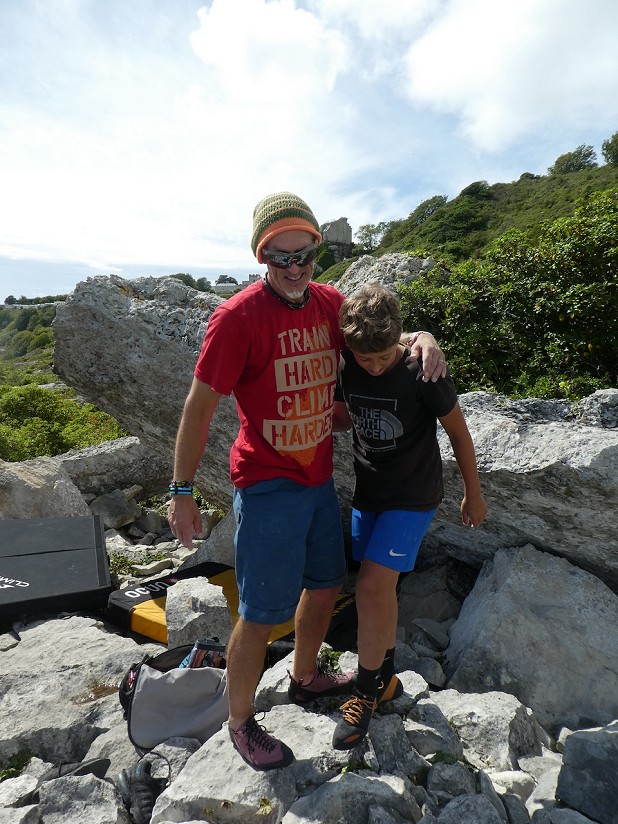
An amazing feeling after though. No amount of visualisation, trying harder and generally using every available skin surface can prepare you for that feeling once you've managed the problem. I'd been thinking about them for so long, wondering if I could manage. That trepidation based on a slight lack of confidence in my own ability and perhaps a slight and ever-growing awareness of my creeping age. Not creeping the right way, either.
***
There is an accepted view that to climb with success requires a combination of physical strength, technical movement and mental awareness. These are definitely the variables under our control. But there are other variables that affect us. As I mentioned earlier, an element of competition seems to help, together with a social element. I almost always climb better with my family or friends with me. For me, the environment helps too. A beautiful, comfortable surrounding with good weather obviously has a positive effect on one's physical and mental state, perhaps adding to the 'desire' or the motivation to climb a particular problem. I have done many more, higher grade problems on Portland than anywhere else, mainly because we go there more often, there are a wide variety of problems and grades, the weather is often good and I know the area really well. All of these aspects coalesce to enable a heightened state, which may or may not be enhanced further through having fun or just enabling a 'try harder' situation.
The inimitable Johnny Dawes described all of this as 'exploring, innovating and doing something previously impossible with new feelings unexpected along with that.' It often amazes me that we can try a problem many times and it feels impossible, but then somehow, something changes, something different happens, often something easily missed or unbelievably small and suddenly, we can climb it. I suppose a lot of it is persistence, training the body, enabling the mind to build up sufficient information, to bridge the elements and make the impossible, possible. Bruce Lee said there are three keys to success, 'persistence, persistence and persistence.'
I saw Johnny trying the moves on an eliminate on Joe's Boulder at The Roaches. He was trying what looked to be the Pink Wall Eliminate, but I think he may have been eliminating it still further, just for fun. He was making the moves look smooth, controlled and well within his comfort zone.
The next time we travelled up to the Roaches, I decided to try his problem, or at least the Pink Wall Eliminate itself; a thin, glassy, seemingly holdless series of lunges and insecure footholds. I tried it a couple of times, the start itself causing a degree of frustration and a test for my patience. My patience obviously wasn't strong enough that day, as I found it really hard to link the moves together without feeling like I was about to slide off the wall.
I think this said a lot about my motivation at the time, as I felt more excited to try the sit start to Joe's Portholes, but eliminating the portholes themselves. It became a toss up in my head as to which problem to focus on. I'd been thinking about Mean Ol' Bastard, 7B, as it's known, for some while, ever since I tried it a couple of times from standing and managed the move up to the high gaston reasonably comfortably, only to feel a little precarious on some slopey slipperiness. However, I managed to throw myself rather clumsily over the top, and then found that it was time to leave.
It gnawed away in my head for ages. I didn't try it from sitting and also didn't finish it properly, my foot ending up in the top 'porthole' as I nearly slid off the top out.
One of those 'try again' moments, only without the opportunity to try again.
I become really frustrated at myself for not making the most of those opportunities, but at the time, it seems fun, we're all trying different problems and it's only later that I fixate on a chance gone…
***
So here I was again, forgoing the pleasures of the Pink Wall and throwing all my eggs into the 'Mean' basket. To be honest, I wasn't particularly confident of my feet on the Pink Wall, whereas, again, I seemed to have decided, somewhere in my sub-conscious that I could do M.O.B.
We had to wait a while for people to finish on the portholes. I always struggle with this. At the local bouldering wall, there's an unwritten rule book for climbing etiquette and there's always a space somewhere. I'm happy waiting for my 'project' and equally other people are very happy to take their turn and respect mine. However outside, there's a bit of an element of 'getting there first' and settling down for a while. Depends where one climbs I suppose, but sometimes big groups seem to take ages to move on. Mainly my impatience more than anything else. The people climbing were just enjoying themselves, no need to rush, taking their time and rightly so. I just get that feeling in my head that by the time they leave, the rock will have worn out, or I'll be too tired, or it'll start raining...desperation!
I smiled politely and tried not to look like I was waiting to get on the problem. Inside, my thoughts and feelings were somersaulting over each other in the desperate clutches of my impatience to get on the rock. Having thought about this problem endlessly since the last time I tried, about a year previously, I was almost exploding in my desire to try my luck. I'd been visualising what I thought the moves were, knew I could get to the right hand gaston, but just wasn't sure about the start.
Eventually, after a thousand years of chalking up, putting my shoes on, gazing at the view, sharing a drink with my wife and dusting off my pads, I was sat at the bottom of the problem, armed with the guidebook, my inner thoughts and a new hat. I always climb in a hat, and this being a new one, I felt it would help me up the route. If not, I could always take it off and try bareheaded, something different!
A last look in the guide.
Nerves, focus, more nerves, a reminder of my own, imagined beta, a quick glance to see that someone was ready to take a picture, (so many times I would somehow manage a really hard problem, tear my fingers to shreds, top out and say
'Did you get a pic?'
only to be greeted with 'oh, we were too busy watching.'
The support crew were armed with the camera.
Nothing for it, but to throw everything I have into this spectacular effort.
My first go was one of those occasions where I couldn't get my feet in the right place,
too high,
too low,
too wide.
So in trying to pull on and move up to a distant hold, I immediately stalled, going nowhere, my foot slipping off.
Do you ever do that thing at the start, where you get your fingers on the start holds, adjust, grip, adjust, then adjust a bit more, then have to start again? I do…
Sitting there, anti-climactically, egg on face, I told myself to get a grip and try again. I didn't think about whether I would manage it, I didn't think of failing, I knew I could get the high gaston. I wasn't totally confident of how to position my feet, but thought I could pop off something with my left hand up to the lip.
I was confident. I had time for a few attempts. I was hugely motivated and had practised it over and over again in my head, imagined pulling over at the top. Imagined the feeling.
It was a good feeling!
So, this go, feet braced, right hand placed in the low porthole, left hand wide of the hold; inside my head…try harder!! Reminds me of what we tell each other at the climbing wall when we can't manage a problem, just do it better!
An 'udge' up to the left hand crimp, pull in, right hip to the rock and a smooth and mostly controlled jerk up to the gaston. I had been here a few times in the past, could never hold it strongly enough to get my left foot positioned to move up to use my left hand. I felt the eyes of the world on me, which was obviously overly dramatic as the only people watching were my wife and kids with maybe the odd passer by looking at my desperate scrabblings on the rock.
Right hand on the gaston and arm now locked. I needed to be strong as I tried to get my left foot up. The rock here was so slippery that I hadn't felt able to trust my feet on my previous attempts, often travelling down the rock faster than up. I found something almost suitable for my left foot and tried to stick it to whatever friction was available, while also bringing my right foot up to something out of sight. Hanging on my right hand and what felt like socks on an ice rink, I pushed through my left foot.
At this point, after several attempts at this problem, I knew exactly what to do and also exactly what not to do, having gradually refined my moves on the rock down to what was absolutely necessary for me. I'd never seen anyone climb it, so I was going with what felt right for me. That left foot held, just long enough to throw, rather frantically, my left hand at something close to the lip. As I held on to something with three of my fingers, my feet flew off and I felt myself peeling off the rock. Somehow I managed to push my right toe into something with friction, which stopped me from falling, while I held onto the lip with my right hand.
Both hands on now, a staggeringly ungraceful last couple of moves, but I was still on. My feet skidding off the sloping ridges, I trusted my left hand and threw my right foot up onto the lip and began to rock over. As my weight moved over my leg, my left hand now slipped, but fortunately my right hand was secure and I hopped my left foot up, as I positioned my hands to mantle. This last move on the problem actually felt good and I think it may even have looked smooth and controlled. I was up, a bit of a battle, but I had managed to do the problem the way I had planned, perhaps with a little extra floundering thrown in.
***
But, why so successful this time? My technique wasn't brilliant, but it had been OK for what I had planned to do.
I had actually felt strong and had felt secure, holding the gaston and locking off, while searching for the elusive footholds. But more importantly, I had felt confident, had followed the plans I'd visualised and knew I could do it! I had time to do the problem, the weather was cool enough for perhaps more friction than I had felt before on this problem and I had the self-belief. Mentally, I was in the right place.
Last year, I saw that Emma Twyford was attempting The Pinch, a V7 at the Sheep Pen in North Wales. She had tried it several times and hadn't been able to climb it, even though it was well within her capabilities. It had become her nemesis. I asked her what had changed, for her to be able to climb it. 'Better weather and cooler conditions definitely helped. Figuring out foot placements and just a general belief that I could do the move instead of being hesitant,' she said.
Belief.
Johnny Dawes has told me in the past that if I know what to do on a move, then just do it, don't keep adjusting fingers, feet, body, just do it. Don't hesitate. I've often been guilty of that hesitancy before making a move, or pausing, losing momentum.
Belief.
I knew that I could climb this problem, I just had to do it. A few attempts, a few mistakes, but everything filtered down to what was needed and mentally, there was no doubt that I would be able to climb it. All those variables that need to coalesce to build the perfect platform for a successful climb mean nothing if the belief isn't there, for me anyway. Also, the moves themselves, each action, each foot placement, each hold — they were all as important, maybe more so than the final top-out.
The journey itself had all the excitement; the balancing act between the physical, mental, environmental, the 'in the moment' inspiration. The destination, when I got there, was immense — but it lasted a split second. Sometimes, the anticipation, the beginning, the doing is so much better than having done it. You only climb it for the first time once. That feeling only exists that time. It gets harder to remember the feeling too. Wish I could bottle it!
Wolfgang Gullich said 'the mind is the most important muscle.' For me, that is the most important thing as it seems to get me through. I'm getting older and I'm not particularly talented, so I need to harness whatever I can throw into the pot. As Jerry Moffatt once said, 'hard work beats talent when talent doesn't work hard.'
Hard work and the mental strength have got me through when perhaps my strength and technique have been found wanting. Also, perhaps the most important aspect; the pure joy of being able to climb. Having the opportunity to go somewhere beautiful with people you love and bond with the rock. The energy from that is intoxicating. It feels like becoming part of the environment and belonging there, enabling that energy to flow through me, the rock, the air…
I met Steve McClure a few years ago. He asked me what my objectives were in climbing. I listened to other people talking about specifics regarding their training, steep climbing, endurance etc., etc. I really wanted to have fun and have adventures and try to climb my hardest while doing so. Simple, but complicated and perhaps not always easy to achieve. But it's always an adventure seeking it out and so far it's also been immense fun.
Climbing is the difference for me. It's kept me going through lockdowns and the lure of new rock, wonderful venues, exciting holds and fresh adventures is my inspiration, my motivation.
What difference does it make?
Everything!
- ARTICLE: Climbing with Age 6 Sep, 2021

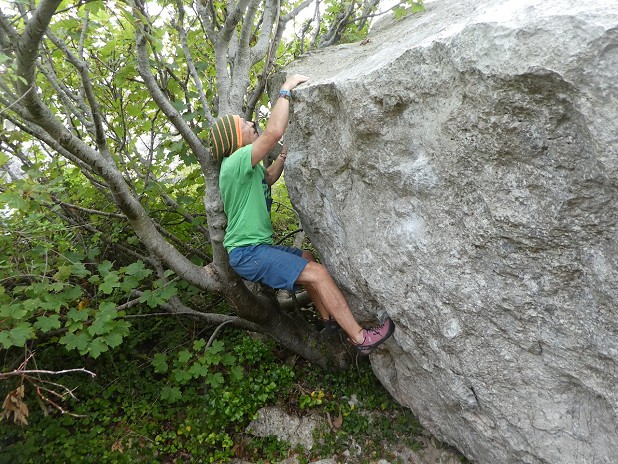
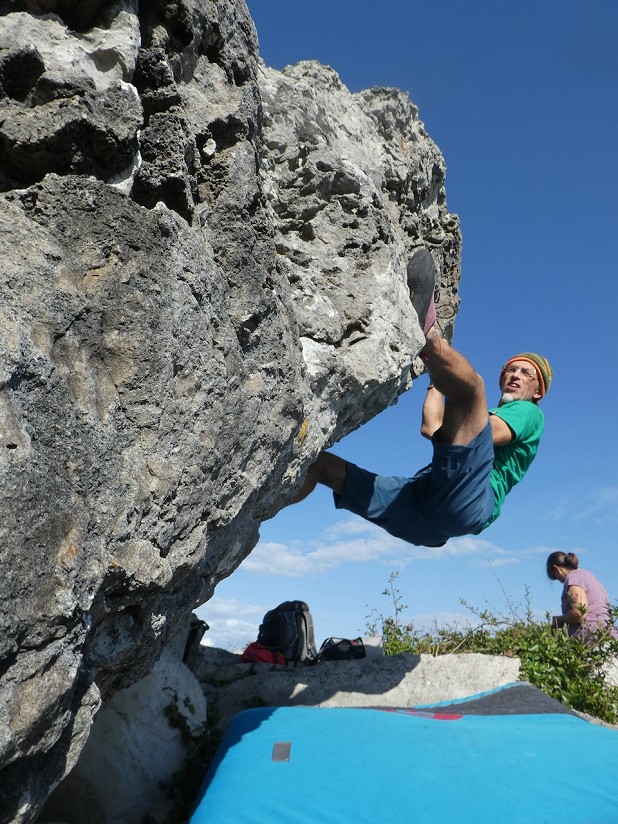
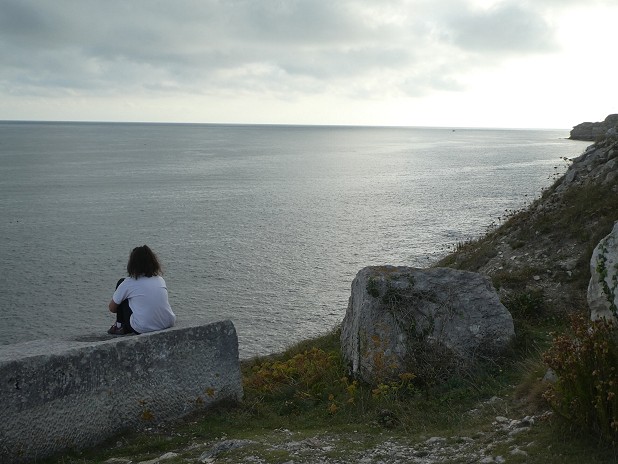
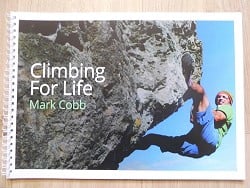







Comments
All men have secrets and here is mine. I got lucky. I was pondering my proudest tick of the year, 4 sessions and droppable in several places. Who knows, it might have been the hips an inch and a half to the right on the critical reach. Explaining a joke makes it not funny. You'd drive yourself mad trying to analyse it. The horror and the beauty of it in one. Nice one Mark!
Volumes of empathy here; lovely piece thanks mate.